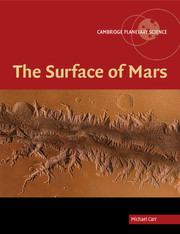5 - Canyons
Published online by Cambridge University Press: 12 August 2009
Summary
Just south of the equator between longitudes 250°E and 320°E are several enormous, interconnected canyons, collectively called Valles Marineris. They extend roughly east–west for over 4000 km from Noctis Labyrinthus at the summit of the Tharsis bulge, down the crest of broad rise on the eastern flank of the bulge, to some low-lying areas of chaotic terrain in Margaritifer Terra, south of Chryse Planitia (Figure 5.1). Regional elevations drop from over 7000 m at the western end of the canyons to less than 1000 m at the eastern end. Most individual canyons range in width up to 150 km, but Melas Chasma is almost 300 km wide, and in the central part of the system three canyons merge to form a depression 600 km across. Along much of the canyon's length, depths are over 6000 m. The deepest parts, in western Coprates Chasma, are over 10,000 m below the canyon rim. By comparison, the Grand Canyon, Arizona, is 450 km long, 30 km across at its widest, and 1700 m below the north rim at its deepest.
The relief of the canyons probably results mostly from faulting. Their origin is thus fundamentally different from that of the Grand Canyon, which was produced almost entirely by erosion, and more akin to that of the African Rift Valleys. Because of the scarcity of fluvial features in the canyons, Sharp (1973a) suggested that the term “canyon,” with connotations of water erosion, was inappropriate. However, we will continue to use the term with the understanding that it has no genetic implication.
- Type
- Chapter
- Information
- The Surface of Mars , pp. 95 - 112Publisher: Cambridge University PressPrint publication year: 2007

